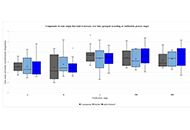
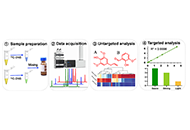
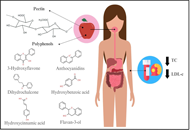
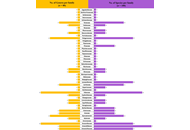
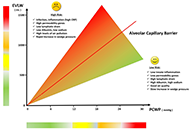
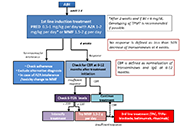
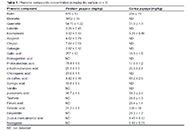
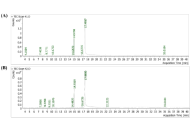
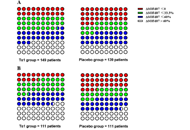
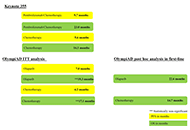
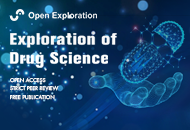
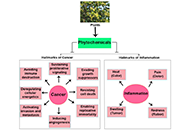
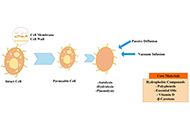
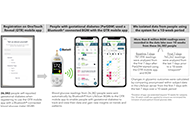

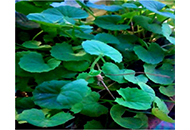
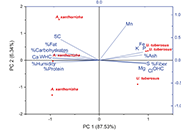
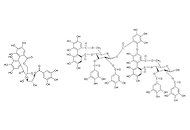
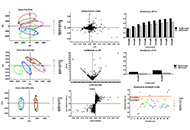
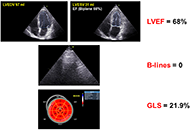

Aim:
Three factors that affect the
Methods:
To study these three factors and their respective interactions, nine vinification protocols were carried out. Must and wine samples were collected at different time points during fermentation, maturation and after bottling, and analyzed by both headspace SPME-GC-MS and RP-LC-TIMS-TOF MS techniques. The findings of the
Results:
In the case of pine
Conclusions:
In the case of pine
Aim:
Three factors that affect the
Methods:
To study these three factors and their respective interactions, nine vinification protocols were carried out. Must and wine samples were collected at different time points during fermentation, maturation and after bottling, and analyzed by both headspace SPME-GC-MS and RP-LC-TIMS-TOF MS techniques. The findings of the
Results:
In the case of pine
Conclusions:
In the case of pine
DOI: https://doi.org/10.37349/eff.2024.00048
This article belongs to the special issue Metrological Aspects in the Analysis of Nutrients, Functional Compounds, Additives and Contaminants in Food and Feed

Aim:
The aim of this study is to comprehensively investigate the distribution of amine and phenol
Methods:
12C-/13C-dansyl chloride labeling was applied for untargeted and quantitative analyses of amine and phenol
Results:
A total of 267 amine/phenol
Conclusions:
The results obtained in the research are beneficial for comprehensively understanding the amine and phenol
Aim:
The aim of this study is to comprehensively investigate the distribution of amine and phenol
Methods:
12C-/13C-dansyl chloride labeling was applied for untargeted and quantitative analyses of amine and phenol
Results:
A total of 267 amine/phenol
Conclusions:
The results obtained in the research are beneficial for comprehensively understanding the amine and phenol
DOI: https://doi.org/10.37349/eff.2023.00007

Aim:
Cardiovascular disease (CVD) are among the main causes of death worldwide and dyslipidemias account for one of the risk factors for these diseases. Habitual apple consumption appears to be inversely associated with reduced cardiovascular risk. Then, this systematic review aims to investigate the effect of chronic apple consumption on the lipid
Methods:
A systematic search was performed in electronic databases, including PubMed, Embase, Web of Science and Scopus, without restriction of year of publication. Inclusion criteria were randomized clinical trials in humans that investigated the effect of chronic consumption of whole fresh or dried apple, for a period longer than two weeks of intervention on the lipid
Results:
Based on the methodology used and following the pre-established search strategies, 4,468 articles were found. After applying the inclusion and exclusion criteria, five articles were selected for qualitative evaluation, covering 522 adult participants of both sexes. Three randomized controlled trials included in this review demonstrated that there was a decrease in plasma total cholesterol (TC), triglyceride and low-density lipoprotein cholesterol (LDL-c) concentrations, in addition to an increase in high-density lipoprotein cholesterol (HDL-c) concentration. Two other studies found different results. Low risk of bias was identified in three studies.
Conclusions:
The analysis of the studies indicates that the consumption of fresh and/or dried apples with the peel has a beneficial effect on the lipid
Aim:
Cardiovascular disease (CVD) are among the main causes of death worldwide and dyslipidemias account for one of the risk factors for these diseases. Habitual apple consumption appears to be inversely associated with reduced cardiovascular risk. Then, this systematic review aims to investigate the effect of chronic apple consumption on the lipid
Methods:
A systematic search was performed in electronic databases, including PubMed, Embase, Web of Science and Scopus, without restriction of year of publication. Inclusion criteria were randomized clinical trials in humans that investigated the effect of chronic consumption of whole fresh or dried apple, for a period longer than two weeks of intervention on the lipid
Results:
Based on the methodology used and following the pre-established search strategies, 4,468 articles were found. After applying the inclusion and exclusion criteria, five articles were selected for qualitative evaluation, covering 522 adult participants of both sexes. Three randomized controlled trials included in this review demonstrated that there was a decrease in plasma total cholesterol (TC), triglyceride and low-density lipoprotein cholesterol (LDL-c) concentrations, in addition to an increase in high-density lipoprotein cholesterol (HDL-c) concentration. Two other studies found different results. Low risk of bias was identified in three studies.
Conclusions:
The analysis of the studies indicates that the consumption of fresh and/or dried apples with the peel has a beneficial effect on the lipid
DOI: https://doi.org/10.37349/eff.2023.00022

Alzheimer’s disease (AD) is a progressive neurodegenerative disease and the most common type of dementia, characterized by cognitive dec
Alzheimer’s disease (AD) is a progressive neurodegenerative disease and the most common type of dementia, characterized by cognitive dec
DOI: https://doi.org/10.37349/en.2025.100697
This article belongs to the special issue Medicinal Plants and Bioactive Phytochemicals in Neuroprotection

Pulmonary congestion is a key determinant of heart failure, but for a long time it has been an elusive target for the clinical cardiologist in the pre-B-
Pulmonary congestion is a key determinant of heart failure, but for a long time it has been an elusive target for the clinical cardiologist in the pre-B-
DOI: https://doi.org/10.37349/ec.2024.00039
This article belongs to the special issue Multimodality Imaging in Ischemic Heart Disease

Autoimmune hepatitis (AIH) is a chronic liver disease of unknown aetiology that can lead to end stage liver disease if left without treatment. Corticosteroids with or without azathioprine (AZA) are considered the recommended standard
Autoimmune hepatitis (AIH) is a chronic liver disease of unknown aetiology that can lead to end stage liver disease if left without treatment. Corticosteroids with or without azathioprine (AZA) are considered the recommended standard
DOI: https://doi.org/10.37349/edd.2024.00042

Aim:
The scope of the present study was to investigate the phyto
Methods:
Total phenolic content (TPC) in the aqueous extracts was determined spectrometrically using the Folin-Ciocalteu (F-C) assay. The identification and quantification of different phenolic
Results:
TPC in the aqueous extracts was found to be 28.0 g gallic acid equivalent (GAE)/kg dry leaves for Psidium guajava leaves aqueous extract and 15.0 g GAE/kg dry leaves for Carica papaya leaves aqueous extract. The dominant phenolic
Conclusions:
Results proved that Psidium guajava and Carica papaya can be provided a strong antioxidant activity and can be used as medicinal plants.
Aim:
The scope of the present study was to investigate the phyto
Methods:
Total phenolic content (TPC) in the aqueous extracts was determined spectrometrically using the Folin-Ciocalteu (F-C) assay. The identification and quantification of different phenolic
Results:
TPC in the aqueous extracts was found to be 28.0 g gallic acid equivalent (GAE)/kg dry leaves for Psidium guajava leaves aqueous extract and 15.0 g GAE/kg dry leaves for Carica papaya leaves aqueous extract. The dominant phenolic
Conclusions:
Results proved that Psidium guajava and Carica papaya can be provided a strong antioxidant activity and can be used as medicinal plants.
DOI: https://doi.org/10.37349/eff.2023.00002

Aim:
The germination of maize leads to many physiological changes in the plant. These changes are responsible for the appearance, disappearance, and variation in concentration of numerous
Methods:
To achieve this, the Atp-Y variety was soaked for 25.12 h at 25.54˚C in the presence of 0.5238% plant ash, germinated for 144.37 h, and matured for 37.65 h. For the Coca-sr variety, the grains were soaked for 1.608 h at 36.63˚C in the presence of 1.1093% plant ash. Germination and ripening took 144.37 h and 27.07 h, respectively. The
Results:
These analyses showed that variety and optimum germination conditions influenced the secondary metabolite
Conclusions:
In view of these results, we would suggest using the Atp-Y variety to benefit from a wide range of
Aim:
The germination of maize leads to many physiological changes in the plant. These changes are responsible for the appearance, disappearance, and variation in concentration of numerous
Methods:
To achieve this, the Atp-Y variety was soaked for 25.12 h at 25.54˚C in the presence of 0.5238% plant ash, germinated for 144.37 h, and matured for 37.65 h. For the Coca-sr variety, the grains were soaked for 1.608 h at 36.63˚C in the presence of 1.1093% plant ash. Germination and ripening took 144.37 h and 27.07 h, respectively. The
Results:
These analyses showed that variety and optimum germination conditions influenced the secondary metabolite
Conclusions:
In view of these results, we would suggest using the Atp-Y variety to benefit from a wide range of
DOI: https://doi.org/10.37349/eff.2025.101087

Aim:
Thymosin alpha 1 (Tα1) is a promising treatment for the improvement of sepsis patients. Until now, its function in reducing acute organ damage of sepsis patients is still unclear. The aim of this study was to determine whether Tα1 can alleviate organ dysfunction in sepsis patients.
Methods:
This study retrospectively enrolled sepsis patients from a multicenter randomized controlled trial [efficacy of Tα1 for severe sepsis (ETASS)]. The sequential organ failure assessment (SOFA) score on day 0 (initial), day 3, and day 7 was collected. Absolute SOFAday07 was defined as initial SOFA score minus SOFA score on day 7 (initial SOFA–SOFA day7). Delta SOFA score (ΔSOFAday07) was provided by the formula: (initial SOFA–SOFA day7) × 100/initial SOFA, and it was expressed as a percentage. After propensity score matching (1:1 ratio), base
Results:
Among 288 enrolled patients, 149 patients received both Tα1 and standard therapy (Tα1 group), and 139 patients received both placebo and standard therapy (placebo group). Compared with the placebo group, the Tα1 group had significantly lower Absolute SOFAday07 [95% confidence interval (CI) 0.8 (0–1.7), P = 0.049]. Among 111 pairs of patients matched by propensity score, the Tα1 group still had lower Absolute SOFAday07 [95% CI 1.0 (0.1–1.9), P = 0.029]. Meanwhile, Tα1 treatment could significantly improve ΔSOFAday07. When the amplitude of ΔSOFAday07 was graded, one third of patients in the Tα1 group had an increase of more than 60%, compared with 22% in the placebo group. Subgroup analysis found that the ΔSOFAday07 improved significantly after Tα1 therapy in sepsis patients with no immunoparalysis at base
Conclusions:
For sepsis patients, Tα1 treatment can alleviate organ dysfunction, and ΔSOFAday07 can be used as an indicator of its therapeutic effect (ClinicalTrials.gov identifier: NCT00711620).
Aim:
Thymosin alpha 1 (Tα1) is a promising treatment for the improvement of sepsis patients. Until now, its function in reducing acute organ damage of sepsis patients is still unclear. The aim of this study was to determine whether Tα1 can alleviate organ dysfunction in sepsis patients.
Methods:
This study retrospectively enrolled sepsis patients from a multicenter randomized controlled trial [efficacy of Tα1 for severe sepsis (ETASS)]. The sequential organ failure assessment (SOFA) score on day 0 (initial), day 3, and day 7 was collected. Absolute SOFAday07 was defined as initial SOFA score minus SOFA score on day 7 (initial SOFA–SOFA day7). Delta SOFA score (ΔSOFAday07) was provided by the formula: (initial SOFA–SOFA day7) × 100/initial SOFA, and it was expressed as a percentage. After propensity score matching (1:1 ratio), base
Results:
Among 288 enrolled patients, 149 patients received both Tα1 and standard therapy (Tα1 group), and 139 patients received both placebo and standard therapy (placebo group). Compared with the placebo group, the Tα1 group had significantly lower Absolute SOFAday07 [95% confidence interval (CI) 0.8 (0–1.7), P = 0.049]. Among 111 pairs of patients matched by propensity score, the Tα1 group still had lower Absolute SOFAday07 [95% CI 1.0 (0.1–1.9), P = 0.029]. Meanwhile, Tα1 treatment could significantly improve ΔSOFAday07. When the amplitude of ΔSOFAday07 was graded, one third of patients in the Tα1 group had an increase of more than 60%, compared with 22% in the placebo group. Subgroup analysis found that the ΔSOFAday07 improved significantly after Tα1 therapy in sepsis patients with no immunoparalysis at base
Conclusions:
For sepsis patients, Tα1 treatment can alleviate organ dysfunction, and ΔSOFAday07 can be used as an indicator of its therapeutic effect (ClinicalTrials.gov identifier: NCT00711620).
DOI: https://doi.org/10.37349/ei.2022.00045
This article belongs to the special issue The Sepsis induced Immune Conundrum

Pembrolizumab combined with chemotherapy has been established as the preferred
Pembrolizumab combined with chemotherapy has been established as the preferred
DOI: https://doi.org/10.37349/etat.2023.00198
This article belongs to the special issue Innovative Strategies to Target Triple-negative Breast Cancer

The outbreak of severe acute respiratory syndrome coronavirus 2 (SARS-CoV-2) infection in December 2019 quickly escalated to pandemic levels and had a severe impact on public health. There are 761 million confirmed coronavirus disease 2019 (COVID-19) cases, with over 6.88 million deaths worldwide till March 2023. Severe cases of the disease caused critical respiratory failure followed by multiorgan involvement. Clinical escalation of COVID-19 has been correlated with markedly increased plasma inflammatory markers [e.g., C-reactive protein (CRP)] and pro-inflammatory cytokine levels [e.g., interleukin (IL)-6, tumor necrosis factor-α (TNF-α)]. Therapeutic options have mostly utilized corticosteroids, antivirals (e.g., remdesivir), and monoclonal antibody-based immunomodulation (e.g., tocilizumab). These existing treatments have adverse side effects, inadequate efficacy, and limitations in administering to patients with comorbidities and other underlying diseases. Monoclonal antibody-based therapies and some of the antivirals are very costly. Many phyto
The outbreak of severe acute respiratory syndrome coronavirus 2 (SARS-CoV-2) infection in December 2019 quickly escalated to pandemic levels and had a severe impact on public health. There are 761 million confirmed coronavirus disease 2019 (COVID-19) cases, with over 6.88 million deaths worldwide till March 2023. Severe cases of the disease caused critical respiratory failure followed by multiorgan involvement. Clinical escalation of COVID-19 has been correlated with markedly increased plasma inflammatory markers [e.g., C-reactive protein (CRP)] and pro-inflammatory cytokine levels [e.g., interleukin (IL)-6, tumor necrosis factor-α (TNF-α)]. Therapeutic options have mostly utilized corticosteroids, antivirals (e.g., remdesivir), and monoclonal antibody-based immunomodulation (e.g., tocilizumab). These existing treatments have adverse side effects, inadequate efficacy, and limitations in administering to patients with comorbidities and other underlying diseases. Monoclonal antibody-based therapies and some of the antivirals are very costly. Many phyto
DOI: https://doi.org/10.37349/eds.2023.00024
This article belongs to the special issue Exploring Potential Drugs from Natural Products

Phyto
Phyto
DOI: https://doi.org/10.37349/eds.2024.00073
This article belongs to the special issue Remedial benefits of natural products in inflammation and cancer

Encapsulation is a pivotal technique for protecting and enhancing the efficiency of sensitive natural bioactive substances, notably essential oils, vitamins, and phenolic
Encapsulation is a pivotal technique for protecting and enhancing the efficiency of sensitive natural bioactive substances, notably essential oils, vitamins, and phenolic
DOI: https://doi.org/10.37349/eff.2024.00037
This article belongs to the special issue Delivery of Hydrophobic Compounds in Food Systems

Aim:
Current diabetes guide
Methods:
Anonymized glucose and app analytics data from 26,382 PwGDM were sourced from a server. Data from their
Results:
Percent fasting readings in range (RIR, < 5.3 mmol/L) improved by +20.3 percentage points in the overall population. Improved glucose RIR (3.5 to 7.8 mmol/L) (+8.3 percentage points), mean blood glucose (BG, –0.59 mmol/L), and fasting RIR (+33.2 percentage points) were observed in those with base
Conclusions:
PwGDM engaged with the diabetes app and connected BGM, facilitating attainment of glycemic targets, an especially important outcome for those with higher mean glucose at base
Aim:
Current diabetes guide
Methods:
Anonymized glucose and app analytics data from 26,382 PwGDM were sourced from a server. Data from their
Results:
Percent fasting readings in range (RIR, < 5.3 mmol/L) improved by +20.3 percentage points in the overall population. Improved glucose RIR (3.5 to 7.8 mmol/L) (+8.3 percentage points), mean blood glucose (BG, –0.59 mmol/L), and fasting RIR (+33.2 percentage points) were observed in those with base
Conclusions:
PwGDM engaged with the diabetes app and connected BGM, facilitating attainment of glycemic targets, an especially important outcome for those with higher mean glucose at base
DOI: https://doi.org/10.37349/eemd.2024.00014
This article belongs to the special issue The Impact of Digitalization To Improve Nutrition and Self-Management in Patients With Diabetes

Aim:
The biorecognition unit of an electro
Methods:
Snail shell HAp (SHAp) material was synthesised from Achatina achatina snail shells and phosphate-containing solutions. The SHAp material was characterised using X-ray diffractometry (XRD), Fourier transform infrared (FTIR) spectroscopy, and Raman spectroscopy to determine the structural configuration, after which it was blended with a conductive polymer [poly(3,4-ethylenedioxythiophene): poly-4-styrene sulfonate (PEDOT: PSS)] to improve the electro
Results:
The CV analysis showed lower peak currents for HEK 293T (50 µA) and PC 12 (120 µA) compared to the RBC (230 µA). Also, the EIS showed impedance values of 0.70 for HEK 293T, 0.62 for PC 12, and 0.52 mΩ for RBC. The findings indicate that SHAp/PEDOT: PSS enables the differentiation of cell proliferation signals through voltammetric and impedimetric measurements.
Conclusions:
The unique current and impedance differences among the cells could serve as potential markers for rapid cell detection.
Aim:
The biorecognition unit of an electro
Methods:
Snail shell HAp (SHAp) material was synthesised from Achatina achatina snail shells and phosphate-containing solutions. The SHAp material was characterised using X-ray diffractometry (XRD), Fourier transform infrared (FTIR) spectroscopy, and Raman spectroscopy to determine the structural configuration, after which it was blended with a conductive polymer [poly(3,4-ethylenedioxythiophene): poly-4-styrene sulfonate (PEDOT: PSS)] to improve the electro
Results:
The CV analysis showed lower peak currents for HEK 293T (50 µA) and PC 12 (120 µA) compared to the RBC (230 µA). Also, the EIS showed impedance values of 0.70 for HEK 293T, 0.62 for PC 12, and 0.52 mΩ for RBC. The findings indicate that SHAp/PEDOT: PSS enables the differentiation of cell proliferation signals through voltammetric and impedimetric measurements.
Conclusions:
The unique current and impedance differences among the cells could serve as potential markers for rapid cell detection.
DOI: https://doi.org/10.37349/eds.2023.00021

Neural disorders refer to conditions of the nervous system due to infection or degeneration of the neurons leading to either neurodegenerative disorder or neuropsychiatric disorder. Some such disorders of the nervous system include Parkinsons’s disease, depression, amnesia, dementia, Alzheimer’s disease, schizophrenia, cerebrovascular impairment, epilepsy, seizure disorders, etc. In conventional medical system, some medicines belonging to the class of psychodelic drugs, sedatives, neurotransmitters, neuro-stimulants, etc. are in extensive use. Unfortunately, most of these drugs either delay the progression of the neural disorder or leave the patient with prominent adverse side effects. Several potent bioactive
Neural disorders refer to conditions of the nervous system due to infection or degeneration of the neurons leading to either neurodegenerative disorder or neuropsychiatric disorder. Some such disorders of the nervous system include Parkinsons’s disease, depression, amnesia, dementia, Alzheimer’s disease, schizophrenia, cerebrovascular impairment, epilepsy, seizure disorders, etc. In conventional medical system, some medicines belonging to the class of psychodelic drugs, sedatives, neurotransmitters, neuro-stimulants, etc. are in extensive use. Unfortunately, most of these drugs either delay the progression of the neural disorder or leave the patient with prominent adverse side effects. Several potent bioactive
DOI: https://doi.org/10.37349/en.2023.00030
This article belongs to the special issue Medicinal Plants and Bioactive Phytochemicals in Neuroprotection

Aim:
The Andean tubers Ullucus tuberosus and Arracacia xanthorrhiza are of great international importance due to their nutritional value (carbohydrates, fiber), functional and phenolic
Methods:
The proximal characteristics were determined as established by the Association of Official Analytical Chemists (AOAC), the functional properties, water holding capacity (WHC), swelling capacity (SC), and oil holding capacity (OHC); and the
Results:
Results revealed that the tubers contain more than 50% carbohydrates, with U. tuberosus having 14% fiber and A. xanthorrhiza having 4.07% fiber. Notably, they are rich in minerals, such as potassium (K), with levels of 4.12% and 3.32% for U. tuberosus and A. xanthorrhiza, respectively. In terms of functional properties, U. tuberosus exhibited a WHC of 0.78 g water/g dry matter (DM), an SC of 1.42 g water/g DM, and an OHC of 0.44 g oil/g DM. In contrast, A. xanthorrhiza showed a WHC of 0.96 g water/g DM, an SC of 3.86 g water/g DM, and an OHC of 0.18 g oil/g DM. Additionally, the study identified various hydroxycinnamic acids, including caffeic acid 4-O-glucoside and p-coumaroyl glucose, as well as methoxyflavonols, such as 3,7-dimethylquercetin.
Conclusions:
These characteristics suggest that the flours could be valuable for the production of bakery products, pastries, pastas, or foods requiring high viscosity. Furthermore, U. tuberosus and A. xanthorrhiza flours have potential applications in the development of functional foods, thus promoting their use and adding value to these tubers produced in the Andean region.
Aim:
The Andean tubers Ullucus tuberosus and Arracacia xanthorrhiza are of great international importance due to their nutritional value (carbohydrates, fiber), functional and phenolic
Methods:
The proximal characteristics were determined as established by the Association of Official Analytical Chemists (AOAC), the functional properties, water holding capacity (WHC), swelling capacity (SC), and oil holding capacity (OHC); and the
Results:
Results revealed that the tubers contain more than 50% carbohydrates, with U. tuberosus having 14% fiber and A. xanthorrhiza having 4.07% fiber. Notably, they are rich in minerals, such as potassium (K), with levels of 4.12% and 3.32% for U. tuberosus and A. xanthorrhiza, respectively. In terms of functional properties, U. tuberosus exhibited a WHC of 0.78 g water/g dry matter (DM), an SC of 1.42 g water/g DM, and an OHC of 0.44 g oil/g DM. In contrast, A. xanthorrhiza showed a WHC of 0.96 g water/g DM, an SC of 3.86 g water/g DM, and an OHC of 0.18 g oil/g DM. Additionally, the study identified various hydroxycinnamic acids, including caffeic acid 4-O-glucoside and p-coumaroyl glucose, as well as methoxyflavonols, such as 3,7-dimethylquercetin.
Conclusions:
These characteristics suggest that the flours could be valuable for the production of bakery products, pastries, pastas, or foods requiring high viscosity. Furthermore, U. tuberosus and A. xanthorrhiza flours have potential applications in the development of functional foods, thus promoting their use and adding value to these tubers produced in the Andean region.
DOI: https://doi.org/10.37349/eff.2024.00058

Alzheimer’s disease, the main cause of dementia worldwide, is a slowly progressive neurodegenerative disorder. This disease involves a diversity of etiophatogenic processes as it is not only a genetic but also a biological and environmental disease. Owing to that complexity, nowadays there is no efficacious treatment for this disorder. The major Alzheimer’s disease clinical indications include extracellular senile plaques of amyloid-β protein, intracellular hyperphosphorylated τ neurofibrillary tangles, uncommon neuroinflammatory response, oxidative stress, and synaptic and neuronal dysfunction. The evaluation of the neuroprotective potential of new
Alzheimer’s disease, the main cause of dementia worldwide, is a slowly progressive neurodegenerative disorder. This disease involves a diversity of etiophatogenic processes as it is not only a genetic but also a biological and environmental disease. Owing to that complexity, nowadays there is no efficacious treatment for this disorder. The major Alzheimer’s disease clinical indications include extracellular senile plaques of amyloid-β protein, intracellular hyperphosphorylated τ neurofibrillary tangles, uncommon neuroinflammatory response, oxidative stress, and synaptic and neuronal dysfunction. The evaluation of the neuroprotective potential of new
DOI: https://doi.org/10.37349/en.2025.100693
This article belongs to the special issue Alzheimer's Disease

Aim:
In this study, Polyphenol and
Methods:
This study investigated the distribution of 15 polyphenolic
Results:
chlorogenic acid, catechin, epicatechin, phloretin were the most abundant components. While phloretin was the dominant component in core, chlorogenic acid was the main phenolic compound in pulp, and quercetin was mainly found in apple peel. The multivariate analysis showed that the
Conclusions:
It indicates that the potential superior biomarker of polyphenols is to differentiate the products from apple core, pulp, and peel respectively. This research provided an insight on the polyphenolic
Aim:
In this study, Polyphenol and
Methods:
This study investigated the distribution of 15 polyphenolic
Results:
chlorogenic acid, catechin, epicatechin, phloretin were the most abundant components. While phloretin was the dominant component in core, chlorogenic acid was the main phenolic compound in pulp, and quercetin was mainly found in apple peel. The multivariate analysis showed that the
Conclusions:
It indicates that the potential superior biomarker of polyphenols is to differentiate the products from apple core, pulp, and peel respectively. This research provided an insight on the polyphenolic
DOI: https://doi.org/10.37349/eff.2023.00013

Aim:
Transthoracic echocardiography (TTE) is the
Methods:
In a prospective, single-center, observational study, from November
Results:
During a follow-up of 14.2 months ± 8.3 months, 72 events occurred: 10 deaths, 11 ACSs, and 51 myocardial revascularizations. In multivariable analysis, B
Conclusions:
TTE with left ventricular ejection fraction (LVEF) can be usefully integrated with STE for GLS, and LUS for B-
Aim:
Transthoracic echocardiography (TTE) is the
Methods:
In a prospective, single-center, observational study, from November
Results:
During a follow-up of 14.2 months ± 8.3 months, 72 events occurred: 10 deaths, 11 ACSs, and 51 myocardial revascularizations. In multivariable analysis, B
Conclusions:
TTE with left ventricular ejection fraction (LVEF) can be usefully integrated with STE for GLS, and LUS for B-
DOI: https://doi.org/10.37349/ec.2023.00007

